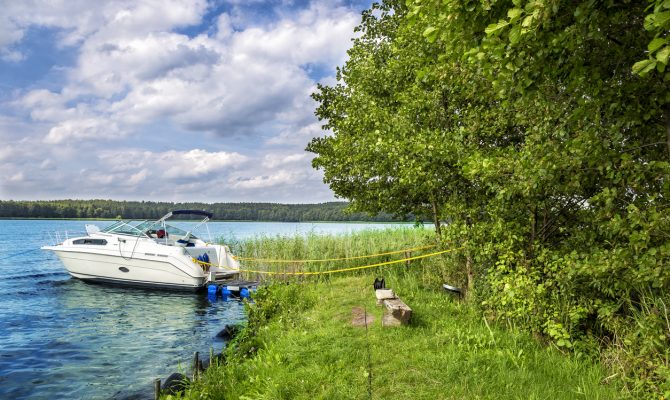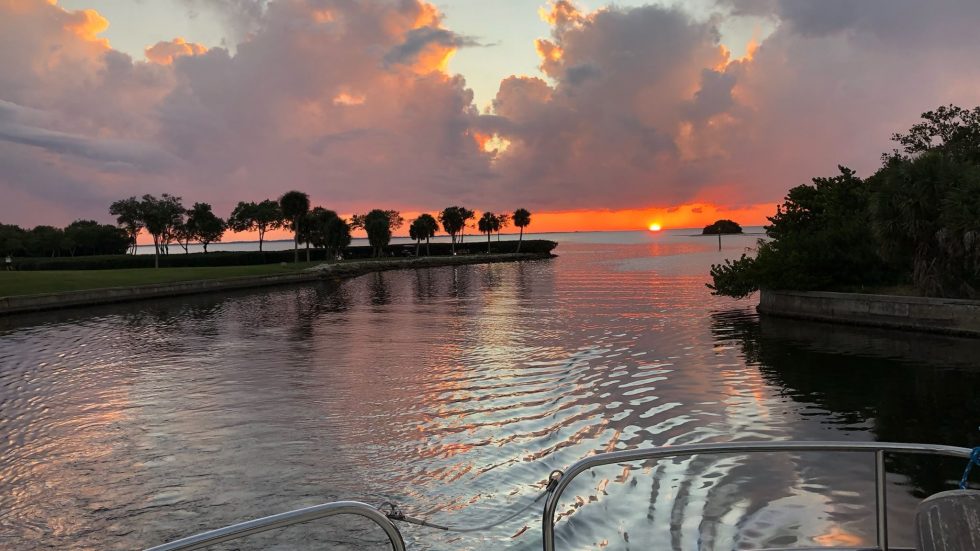One of the best things about a boat is the ability to visit new places that may not be accessible via roads. This can go well beyond the typical sightseeing cruises with friends or family. With a little bit of planning, your boat, as long as it is comfortable for at least a four-hour ride, can be used as a waterways Conestoga wagon. Many major waterways allow you to hop from one campground to another, but with a boat, you can also go camping on islands that are not accessible by roads, such as large stretches of the Mississippi River. With a bit of pre-planning it’s not usually too difficult to map out overnight destinations along the route you wish to take. If there are no designated campgrounds where you want to tie up for the night, some marinas will allow an overnight stay in your tent, provided you call ahead to confirm this in advance; don’t just show up expecting to be welcomed with open arms.
No Head? No Problem
Many boats have most of the same basics found in an RV, which makes them ideal for waterway camping: a head, a galley, and staterooms or even ample seating areas that can double as a place to sleep. This makes most express cruisers or houseboats a natural for waterway camping in air-conditioned comfort. But even if your boat is a bowrider or a pontoon boat that doesn’t have a head or even a cabin, you can adapt it for camping with the addition of sleeping bags, a cooler for food, a camping stove, and a 5-gallon container of fresh water.
If the seats are large enough to stretch out on, you can opt to sleep aboard or simply pack a tent to spend the night on dry land. Depending on your level of adventure, tents range from large, spacious “cabin” styles to tiny backpacking tents that weigh only a few pounds. If your boat is not equipped with a head, you will need to either bring a portable head or plan your route to have easy access to potty breaks when nature calls. Pre-planning also means knowing where to find showers, laundromats, food stores, fuel docks and sightseeing opportunities along the way. At various times, these will all rotate to the top priority of the day. On a semi-related note, personal wipes will be something you will soon learn to love while spending the day on the boat, cruising along.
Boats with open deck layouts are perfect for carrying your camping supplies. Depending on how many people you have on board, even a small bowrider has plenty of room to carry supplies and food. If the boat is on a trailer, your options expand even more, since you can keep exploring even when you run out of road.
Weather or Not
The time of year and the weather will play a large role in deciding how far to go as well as when to go. Up north, boat camping will be most practical in the summer, but down south, you can go boat camping pretty much year round. Cold or hot weather will be a deal-breaker for some, and bugs are a universal problem. Ample amounts of bug spray and possibly a mosquito tent may be needed if you camp near marshy areas that will come alive with biting, buzzing guests as soon as the sun sets.
Traveling with kids? Bring their handheld electronic games to keep them occupied and, if the boat is large enough, consider bringing along a kayak or a standup paddleboard to do more exploring once you’ve reached the day’s destination.
What to Bring
-
- Food: one or two coolers can hold a few days’ supplies, but plan to shop along the way
-
- Sleeping bags and air mattresses
-
- Bugs: don’t bring any, there will be plenty along the way, which is why you’ll want bug spray and maybe even mosquito netting
-
- Clothes: Bring a few days’ clothing, to include bathing suits, hiking boots for shoreside excursions, rain gear and something to change into to explore nicer dining after you get sick of campfire food
-
- Sunblock: plenty of high-SPF sunblock (40 and above)
-
- Sunglasses: preferably with polarized lenses
-
- First Aid kit
-
- Trash bags
-
- Fresh water: at least 5 gallons of fresh water per day
-
- Stove: small propane stoves are easy to use
-
- Utensils and plates: paper plates and paper towels, plus basic utensils and barbecue cooking tools
-
- Dishwashing liquid
-
- Binoculars/camera
-
- Prescriptions and personal hygiene items
-
- Cellular phone with spare batteries
-
- GPS
-
- Maps/charts
-
- Power cords/12V adapters
-
- A basic tool kit and a few spare parts: duct tape, fuel filter
-
- Cash and credit cards
-
- 30 feet of line
-
- Spare anchor
-
- Fenders and dock lines
-
- A good knife and fire-starting essentials, just in case you need to lash something down
-
- USCG basics (flare kit, distress signals, etc)
Words of Caution
Just because you are channeling your inner Huck Finn, don’t assume the world will share your enthusiasm. This means you can’t tie up anywhere you please, such as parks, waterfront hotels or other municipal, public or privately-owned properties without getting permission to do so, either in advance or when you arrive.
Pay attention to your chartplotter. Just because you are “sure” there’s plenty of water up ahead, pay heed to the chartplotter and stay in the channel. You don’t have a chartplotter on the boat? Invest in a hand-held unit that has a screen that can be viewed in full sunlight, along with a 12V power plug.




